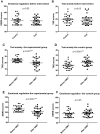Effect of group impromptu music therapy on improving test anxiety and emotional regulation ability in medical students
- PMID: 39726618
- PMCID: PMC11670072
- DOI: 10.3389/fpsyg.2024.1467830
Effect of group impromptu music therapy on improving test anxiety and emotional regulation ability in medical students
Abstract
Introduction: Test anxiety, a prevalent psychological issue among medical students, can profoundly impact their social, behavioral, and emotional development. This condition is significantly associated with challenges in emotional regulation, and to date, no effective clinical treatment has been established to address it. This study aimed to investigate the potential benefits and effects of group impromptu music therapy (GIMT) on enhancing emotional regulation skills and alleviating test anxiety in medical students.
Methods: A total of 29 participants in the experimental group and 30 participants in the control group were finally included for data analysis. Four weeks prior to the final exams, the experimental group commenced GIMT treatment, while the control group did not receive any intervention. Following the four-week intervention period, both groups were assessed using standardized scales and follow-up semi-structured interviews.
Results: The results revealed that students given the GIMT intervention reported significantly lower levels of test anxiety, as measured by the Test Anxiety Scale (TAS), and experienced fewer difficulties with emotional regulation, as indicated by the Difficulties in Emotion Regulation Scale (DERS). Additionally, these students achieved higher examination scores than the control group. Qualitative data from semi-structured interviews further supported these observations.
Discussion: Collectively, these findings demonstrate that GIMT is an effective method for enhancing the emotional regulation abilities of medical students and for relieving the symptoms of test anxiety, ultimately resulting in better academic performance. The study also indicates that GIMT could be a promising clinical auxiliary method for dealing with test anxiety and should be considered for inclusion in the curriculum of healthcare professional education programs. Nonetheless, more efforts are needed to address the limitations of this method before it can be widely used for clinical practice.
Keywords: emotional regulation; group impromptu music therapy; improvement; medical students; test anxiety.
Copyright © 2024 Song, Xiao, Wang, Li, Liu, Zhang, Liu, Zhang and Zhang.
Conflict of interest statement
The authors declare that the research was conducted in the absence of any commercial or financial relationships that could be construed as a potential conflict of interest.
Figures


Similar articles
-
Effect of Group Impromptu Music Therapy on Emotional Regulation and Depressive Symptoms of College Students: A Randomized Controlled Study.Front Psychol. 2022 Mar 31;13:851526. doi: 10.3389/fpsyg.2022.851526. eCollection 2022. Front Psychol. 2022. PMID: 35432107 Free PMC article.
-
Mindfulness's moderating role applied on online SEL education.Front Psychol. 2024 Nov 19;15:1499357. doi: 10.3389/fpsyg.2024.1499357. eCollection 2024. Front Psychol. 2024. PMID: 39629188 Free PMC article.
-
Test anxiety, emotional regulation and academic performance among medical students: a qualitative study.Med Educ Online. 2025 Dec;30(1):2505177. doi: 10.1080/10872981.2025.2505177. Epub 2025 May 17. Med Educ Online. 2025. PMID: 40380803 Free PMC article.
-
Behavioural modification interventions for medically unexplained symptoms in primary care: systematic reviews and economic evaluation.Health Technol Assess. 2020 Sep;24(46):1-490. doi: 10.3310/hta24460. Health Technol Assess. 2020. PMID: 32975190 Free PMC article.
-
Effectiveness of high fidelity simulation versus low fidelity simulation on practical/clinical skill development in pre-registration physiotherapy students: a systematic review.JBI Database System Rev Implement Rep. 2019 Jun;17(6):1229-1255. doi: 10.11124/JBISRIR-2017-003931. JBI Database System Rev Implement Rep. 2019. PMID: 30964770
Cited by
-
The impact of online upward social comparisons on cyberbullying in the post-epidemic era: a moderated mediating model.Front Psychol. 2025 Jul 23;16:1597985. doi: 10.3389/fpsyg.2025.1597985. eCollection 2025. Front Psychol. 2025. PMID: 40777227 Free PMC article.
References
-
- Baldwin D. S., Anderson I. M., Nutt D. J., Bandelow B., Bond A., Davidson J. R. T., et al. . (2005). Evidence-based guidelines for the pharmacological treatment of anxiety disorders: recommendations from the British Association for Psychopharmacology. J. Psychopharmacol. 19, 567–596. doi: 10.1177/0269881105059253, PMID: - DOI - PubMed
LinkOut - more resources
Full Text Sources

